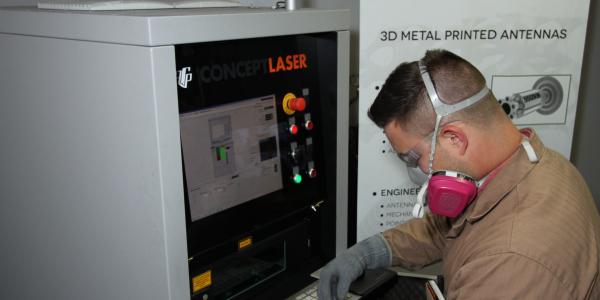3-D Printed Metal Antennas Are no Longer Science Fiction
The combination of so-called additive manufacturing, or 3-D printing, electromagnetic simulation and mechanical design software is enabling innovative antenna and radio-frequency components. Engineers are harnessing these tools to design, fabricate, test and manufacture lightweight, highly complex antennas and radio-frequency products.
The products are an order of magnitude smaller and lighter than what is on the market today, says an official at antenna design company Optisys LLC, West Jordan, Utah. This was not even possible five years ago, reports Michael Hollenbeck, chief technology officer and a co-founder of Optisys.
The resulting products are catching customers in almost disbelief. “We see this response when we drop one of our antennas in someone’s hands, and they are anticipating a heavy block of metal,” he says. “And then it’s so light, they cannot believe it.” Hollenbeck has to explain that it is in fact a full-density aluminum part. “The products are sparking the imagination of a lot of people,” he shares. “We’ve had really excellent reception.”
Hollenbeck calls it mass customization of high-performance antennas and radio-frequency products. In particular, 3-D printing is allowing added complexity and capabilities never before achieved in the radio-frequency and antenna industry—the reduced weight, integration of multiple parts, assembly reductions, design flexibility and creation of shapes not possible with traditional processes.
Conventional waveguide structures are a lot larger and heavier than they need to be, Hollenbeck continues. Traditional manufacturers have to tool every process when making an antenna. “Whereas we just change our geometry in our simulation and hit print,” he says. “We are able to customize for every single application and do it better than a traditional process. The parts don’t require any tuning and effectively work right off of the printer.”
Take the company’s 16-element monopulse 30 gigahertz (GHz) tracking antenna. “That is one structure that would normally have more than 100 different parts, and it would be over 10 inches long and weigh over 10 pounds,” Hollenbeck says. “We were able to reduce it to 2 inches long, and it weighs less than 2 ounces and is a single part. We’ve verified the performance to show it works from the first print.”
For printing, Optisys has turned to GE Additive’s Concept Laser 3-D printers, which range in size from a machine the equivalent of one household refrigerator up to a machine the size of six refrigerators. According to Concept Laser, which was founded in Germany in 2000, the printers allow a “tool-free, economic fabrication of highly complex components in fairly small batch sizes.” The company’s customers come from many different market sectors, including medical and dental, toolmaking and mold construction, automotive, and the watch and jewelry industries. The aerospace industry and 3-D printing share a symbiotic relationship. “With 3D-printing, production methods are breaking new ground all the time,” according to the company. “The unwritten motto of 3-D experts seems to be the desire to continually test the limits of the technology.”
For Optisys’ purposes, the 3-D printers—along with electromagnetic field design software and 3-D printing simulation software, among other tools, from Canonsburg, Pennsylvania-based ANSYS Incorporated—are used to come up with the best designs for radio-frequency and antenna applications. (See Software Reshapes 3-D metal Printing.) “What we really focus on is how do we reimagine how a complex RF structure can be designed in the smallest possible volume that it can occupy,” Hollenbeck says.
While the printing itself might seem easy and fast—printing takes only a day or two—expertise in radio-frequency and antenna design is crucial. “There is a special finesse that has to be taken with RF parts, as they are very sensitive to internal structures,” says Hollenbeck, who holds a patent in monopulse tracking design. “If you don’t know which components inside the RF part are critical, then it’s very unlikely that just sending it out to get 3-D printed is going to work.”
Optisys can make “really any antenna or part,” Hollenbeck says, between 10 megahertz (MHz) and 100 GHz and in the X-band, Ku-band, K-band, Ka-band, Q-band, V-band and E-band frequencies, as well as custom waveguide sizes and shapes, such as ridged, square, circular and elliptical. “What we like to do is get a systems specification, rather than getting a specification for one discrete part,” he says. “We want to see what the customer wants the system to do and look at the application and find the best solution to that.” For customers that have core competencies they like to maintain, Optisys also can fabricate just a portion of a system.
The company prints in powdered aluminum for the majority of its designs, but it also uses other metals. “For high frequency situations, the correct choice is aluminum,” Hollenbeck says. “Aluminum is in this really great spot as far as a balance of mechanical properties and radio-frequency properties. It has a fairly high level of conductivity, we get good performance out of it, and it’s strong and lightweight.” It also meets the military’s specification requirements for shock and vibration.
Adjacent components in an antenna system also can benefit from strong metals such as titanium, steel, cobalt chrome or a number of others. “There are situations in which it is nicer to use these other metals for strength and plating properties,” Hollenbeck notes. “Those metals have significantly worse conductivity, though. So while they may have a higher strength for the material, you tend to have to expect higher losses given the physics and conductivity. Then as you go to more conductive materials, such as copper, silver and gold, they are not really that strong. They are very malleable metals. So we have to pick the metals that are appropriate for certain applications.”
Although printing in gold can be done, Optisys does not do it, understandably, because of the cost. Moreover, working with powdered aluminum—or any powdered metal—requires a controlled environment and correct industrial processes and procedures to minimize risks and ensure safe handling.
During the printer’s powdered bed fusion process, a thin layer of powder is scraped over a build plate, then the high-powered laser welds the metal to the structure below, Hollenbeck explains. The plate drops down a layer, more powder is applied, then the laser welds another layer. The iterative process grows the designed structure. At the end, any unneeded powdered metal is shaken out and reused. “It’s a very green process,” Hollenbeck assures.
“It’s essentially a laser in a box, with a powder delivery system with argon gas or carbon dioxide,” adds Steve Pilz, lead product manager at ANSYS and an expert in additive manufacturing. “During the process, the laser runs over the powered metal, which looks likes dust, and as the laser hits the powder, it essentially welds it together and adheres the metal to the layer underneath it. The laser is very, very fast. It goes back and forth, and where it doesn’t touch, you can sweep that away. Where it does hit, it becomes solid metal.”
The resulting products include waveguide arrays, antenna arrays, feeds and subreflectors, lattice structures, orthogonal mode transducers and polarizers, antenna horns, connectors and control systems. They can be used in military and commercial applications, such as line-of-sight platforms, satellite communications (SATCOM), radar, unmanned aerial vehicles (UAVs), manned aircraft and man-packable applications on the ground, in aircraft or in space. “Any antenna platform that stands to benefit from reduced size and/or reduced weight while maintaining high performance will benefit from these products,” Hollenbeck promises.
Smaller and lighter radio-frequency and antenna components in UAVs will extend flight time or reduce fuel costs. For soldiers, lighter antennas lessen their pack burden. “If we can pull the weight out of a SATCOM antenna, then that gives extra weight for soldiers to carry the critical things that they need to bring while also giving them a SATCOM datalink,” Hollenbeck says.





Comments